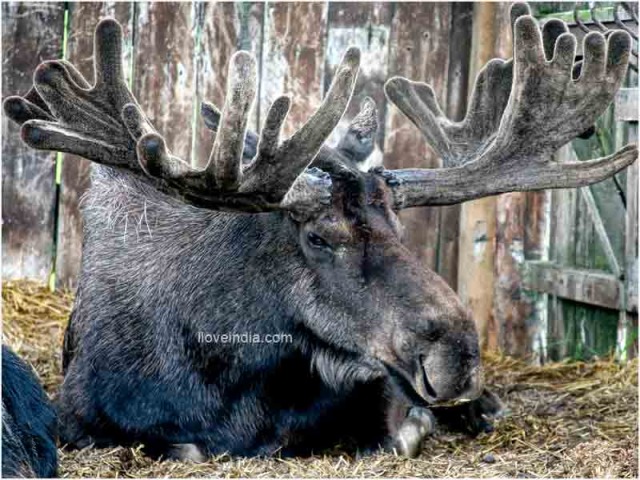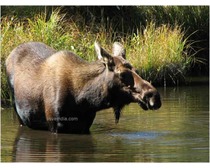The most fascinating fact about moose is that it is the largest of the deer species. Go through the below lines to know some more interesting facts and amazing information on moose, aka common elk.
Facts About Moose
Moose is the largest of the deer species, which inhabits the boreal and mixed deciduous forests of the Northern Hemisphere. The animal is called moose in North America, whereas in Europe, it is known by the name of common elk. The word moose has been derived from the Algonquian Eastern Abnaki name moz, which literally means ‘twig eater’. The male moose is called a bull, whereas the female is known by the name of cow. Moose is a diurnal animal that feeds on plants and vegetations. Basically calm by temperament, moose can turn ferocious when threatened. Get to know some more interesting facts and amazing informationon moose, through the below lines.

Facts About Moose
Kingdom: Animalia
Phylum: Chordata
Class: Mammalia
Order: Artiodactyla
Family: Cervidae
Subfamily: Capreolinae
Genus: Alces
Species: A.alces
Binomial Name: Alces alces
Length: Height at shoulder – 6-7 ft
Weight: Male: 380-720 kg; Female: 270-360 kg
Lifespan: 15-20 years in wild
Diet: Herbivore
Range: Europe and North America
Habitat: Boreal and Mixed deciduous forests of Northern Hemisphere
Call: Whistle-like call and grunts
Mating Time: September and October
Gestation Period: 8 months
Number of Offspring: 1; sometimes 2
Interesting & Amazing Information On Common Elk
- The adult moose has a dark brown coat, whereas its young ones have a coat that is reddish brown in color.
- An adult common elk will need approximately 9,770 calories per day to maintain its health.
- The male moose has large antlers on its head, which are in the shape of twigs. The antlers are absent in female moose.
- Immediately after the mating season, the male moose drops its antlers. It grows a new set of antlers in the spring season.
- Moose’s antlers are the fastest growing organ in the animal, as they develop fully within a short period of three to five months.
- Once the antlers of a common elk are grown completely, it first sheds a layer of skin known as velvet, before shedding the antlers.
- In many countries, moose is hunted as a game species. In some parts of the world, it is also eaten as an alternate to red meat.
- It does not harm humans, unless it is provoked or frightened. A male moose may show aggressive behavior towards human beings when it is confronted during its mating season. Female moose generally attacks human when it sees a threat to its calves.
- Like any other wild animal, moose is unpredictable in its behavior.
- Because of its height, a common elk prefers to feed on taller shrubs and plants.
- During winter season, moose is seen feeding on shrubs and pinecones. It also scrapes snow, using its hooves, to find mosses and lichens.
- The animal roams around in small groups during summers. In winter, sometimes, it forms large herds.
- The hooves of a moose helps it travel smoothly across snow in winter and through muddy and marshy ground in other seasons.
- Moose can run a distance of around 35 miles in an hour and can trot steadily for 32 kilometers in an hour.
- Despite being heavy, the common elk makes a good swimmer. It can swim several miles at a stretch and can even submerge in water completely, for about 30 seconds.
- Moose also eats the water plants growing in marshes and lakes. It pushes its head inside the water to find the roots and stems of underwater plants.
- In the mating season, the male common elk bellows loudly, in order to attract the female.
- Generally, the solitary bulls are seeing fighting against each other with their antlers, in order to declare their supremacy.
- Moose can kick out in all directions. However, it generally uses its front feet for the purpose.
- A common elk has poor eyesight and mainly depends on its sense of smell. It generally stops while eating and often listens to its surrounding.


See also
More from iloveindia.com
- Home Remedies | Ayurveda | Vastu | Yoga | Feng Shui | Tattoos | Fitness | Garden | Nutrition | Parenting | Bikes | Cars | Baby Care | Indian Weddings | Festivals | Party ideas | Horoscope 2015 | Pets | Finance | Figures of Speech | Hotels in India : Delhi | Hyderabad | Chennai | Mumbai | Kolkata | Bangalore | Ahmedabad | Jaipur
- Contact Us Careers Disclaimer Privacy Policy Advertise With Us Lifestyle Sitemap Copyright iloveindia.com. All Rights Reserved.



